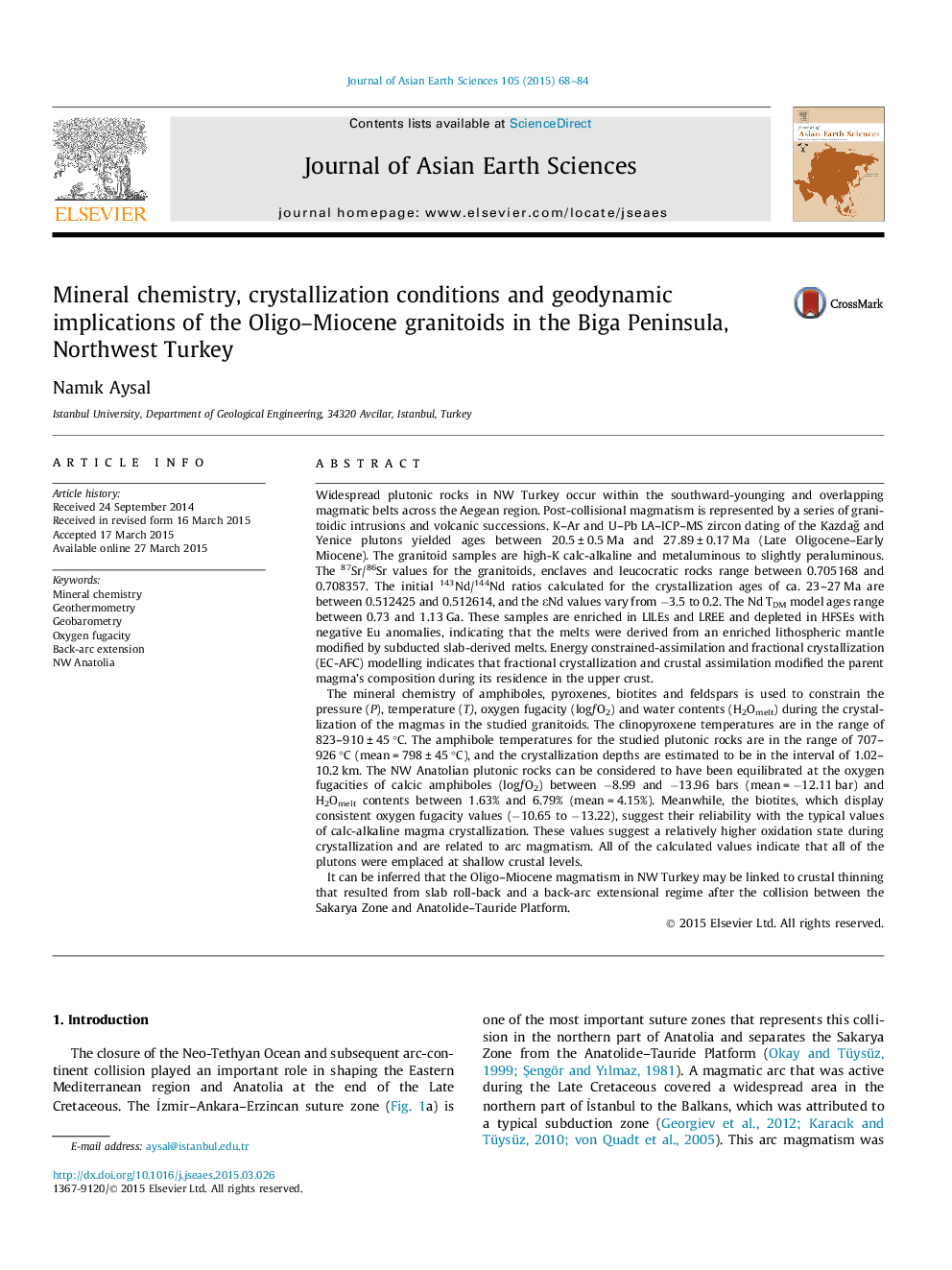| کد مقاله | کد نشریه | سال انتشار | مقاله انگلیسی | نسخه تمام متن |
|---|---|---|---|---|
| 4730486 | 1640364 | 2015 | 17 صفحه PDF | دانلود رایگان |
• Post-collisional magmatic activities are represented by a series of granitoids and volcanics.
• Mineral chemistry data indicates that all plutons emplaced at shallow crustal levels.
• The Oligo–Miocene plutonism is related to retreat and roll-back of the Hellenic slab.
Widespread plutonic rocks in NW Turkey occur within the southward-younging and overlapping magmatic belts across the Aegean region. Post-collisional magmatism is represented by a series of granitoidic intrusions and volcanic successions. K–Ar and U–Pb LA–ICP–MS zircon dating of the Kazdağ and Yenice plutons yielded ages between 20.5 ± 0.5 Ma and 27.89 ± 0.17 Ma (Late Oligocene–Early Miocene). The granitoid samples are high-K calc-alkaline and metaluminous to slightly peraluminous. The 87Sr/86Sr values for the granitoids, enclaves and leucocratic rocks range between 0.705168 and 0.708357. The initial 143Nd/144Nd ratios calculated for the crystallization ages of ca. 23–27 Ma are between 0.512425 and 0.512614, and the εNd values vary from −3.5 to 0.2. The Nd TDM model ages range between 0.73 and 1.13 Ga. These samples are enriched in LILEs and LREE and depleted in HFSEs with negative Eu anomalies, indicating that the melts were derived from an enriched lithospheric mantle modified by subducted slab-derived melts. Energy constrained-assimilation and fractional crystallization (EC-AFC) modelling indicates that fractional crystallization and crustal assimilation modified the parent magma’s composition during its residence in the upper crust.The mineral chemistry of amphiboles, pyroxenes, biotites and feldspars is used to constrain the pressure (P), temperature (T), oxygen fugacity (logƒO2) and water contents (H2Omelt) during the crystallization of the magmas in the studied granitoids. The clinopyroxene temperatures are in the range of 823–910 ± 45 °C. The amphibole temperatures for the studied plutonic rocks are in the range of 707–926 °C (mean = 798 ± 45 °C), and the crystallization depths are estimated to be in the interval of 1.02–10.2 km. The NW Anatolian plutonic rocks can be considered to have been equilibrated at the oxygen fugacities of calcic amphiboles (logƒO2) between −8.99 and −13.96 bars (mean = −12.11 bar) and H2Omelt contents between 1.63% and 6.79% (mean = 4.15%). Meanwhile, the biotites, which display consistent oxygen fugacity values (−10.65 to −13.22), suggest their reliability with the typical values of calc-alkaline magma crystallization. These values suggest a relatively higher oxidation state during crystallization and are related to arc magmatism. All of the calculated values indicate that all of the plutons were emplaced at shallow crustal levels.It can be inferred that the Oligo–Miocene magmatism in NW Turkey may be linked to crustal thinning that resulted from slab roll-back and a back-arc extensional regime after the collision between the Sakarya Zone and Anatolide–Tauride Platform.
Journal: Journal of Asian Earth Sciences - Volume 105, 1 June 2015, Pages 68–84
